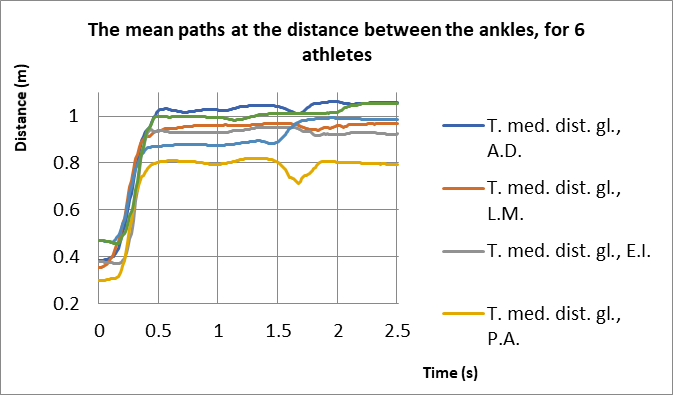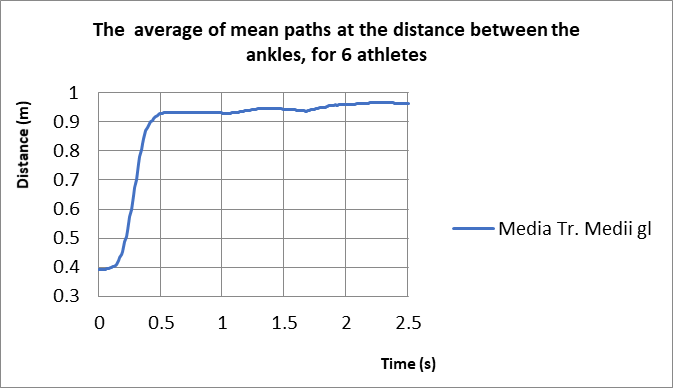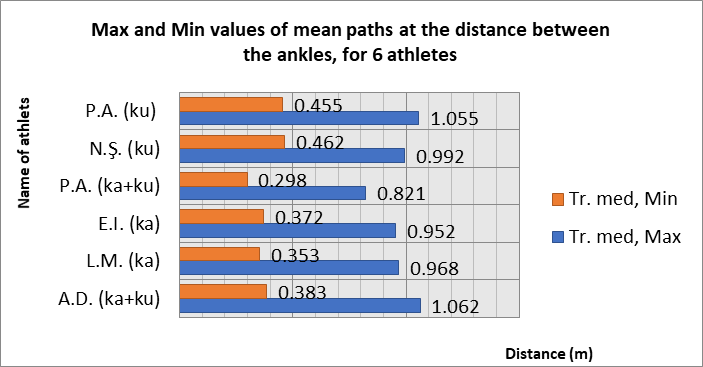Abstract
Purpose of this paper is to analyse some kata Heian Nidan techniques, to observe differences in execution, especially on lower limbs movement and possible comparison with reference data. Methodology, research was conducted in the biomotric laboratory of the N.I.S.R. Bucharest, and consisted in achieving some tests, 12 repetitions on 6 athletes, with averages: age = 18,83y±1,72, height = 169,33cm±8,57 and weight = 57kg±3,57, relating to kinematic characteristic of motion, in the kata mentioned before. We use an inertial navigation system that contains 17 sensors - MVNBiomech, produced by XSENS Technologies BV. Athletes tested holds a black belt, they practice karate for 8 years. The results obtained refers to the distance between ankles, on a total of 12 repetitions from kata sequence selected. The average values of distance between left and right leg, in kokutsu dachi position is M min = 0,387m ± 0,200 and M max = 0,975m ± 0,490, while C.V. min = 2.189% and C.V. max = 8.605%. Conclusions. We observe that the average values are representative and homogeneity is high. Comparing the result with reference data, which recommend for kokutsu dachi position that the athlete must maintain an ankle distance of maximum 0,91m for seniors, our study has highlighted a higher value - 0,975m (Dif. = 6,5 cm), which is difficult to observe with free eye, especially for the referee. Using such an analysis system will be easier for referee to judge, but also for coaches, to correct the mistakes in real time.
Keywords: Motion analysisperformancekata exercise
Introduction
Nowadays, when sport experiencing a great development, it is very important how judges evaluate with precision and rightness the winner; also, how coaches and athletes prepare for all the factors of training, but especially for the technical factor.
That is why the role of specialists involved in sports science for finding the best solutions and training methods will be more and more important, and those athletes who will benefit from the discoveries and benefits of the new technologies as well as the contribution of interdisciplinary teams for training will have higher chances to be at the top of the rankings (Gagea & Tiron, 2007).
The kata exercises being of high complexity, require a physical and emotional balance, but also a special coordination (Amălinei, 2010). From kata competitions, we notice that athletes realize technical elements with larger or smaller differences, being scored differently. We believe that appraisal and scoring can sometimes be subjective, especially in competitions with many participants (Fidalgo, 2013; Morris, 2015). Thus, a solution to objectivize the arbitration process (decision-making) we consider to be welcome, both for the referees and especially for the athletes competing.
Problem Statement
In karate, especially in the kata category, from a biomechanical point of view it is very important how each movement and technical element is made to achieve victory. We believe that in order to eliminate some mistaken decisions by referees, or to be very correct in the evaluation, it would be appropriate to use kinematic motion analysis systems which work with inertial sensors (Ardelean, Hillerin, & Bidiugan, 2014). Also these systems can be of real use in the training process of athletes, to get the information in real time and to intervene precisely on the wrong part of the movement (Hillerin, 2005).
This type of technology has a wide applicability and can be used in many areas, such as recovery, virtual reality, animation, automotive, etc. In sport, it is also applied successfully in biomechanical analyzes or other applications for sports science (Stergiou, 2004). Also, a number of authors have used this system to analyze the movement in martial arts (Hachaj, Piekarczyk, & Ogiela, 2017; Cynarski, Wajs, & VencesBrito, 2014; Ardelean, 2015).
Through this paper we aim to analyze the fundamental position kokutsu dachi (more precisely, the distance between the ankles of the lower limbs), a position often used by athletes in both kata and kumite competitions (Japan Karate Association, 2017). A too small or to big distance between the ankles can affect both the technical aspect of the execution and the dynamic balance of the athlete. We also want to compare our results with other data related to this parameter in the literature.
So, using this technology with inertial sensors to measure the distance between left and right leg ankles on the y axis, for six experienced karate practitioners, we will actually have the following data: - initial distance between ankles before start; - trajectory which the ankle goes through; and - the end point in which the athlete places his foot on the ground, indicating the maximum distance between the ankles. Regarding the distance between the lower limbs in the kokutsu dachi position, some specialists claim that for a correct execution it can reach certain lengths, such as: - between 30 and 36 inches [76,2 cm şi 91,4cm] (Kirkham , 2001), while other specialists indicate: two shoulder widths or 2-3 basin widths (Doder, 2008), or a length between heels of 80 cm (Nakayama, 1977). Also note that this distance is not the only feature of this position.
For a better assessment and correctness of the techniques performed by the tested athletes, or the total execution time of the kata sequence, and the time to accomplish the technical elements under my analysis, I have consulted and observed a series of demonstrations by some international masters especially Japanese) who executed the kata element chosen for recording - Heian Nidan. (Kanazawa, 2014; Kagawa, 2014; Kawazoe, 2014).
Research Questions
In this paper we worked on hypotheses to answer, among other things, to the following questions:
If we can perform a qualitative analysis (trajectories of the segments or the whole body on the move, on the three coordinates x, y, z), with karateka athletes who perform a technical element from a martial arts kata category exercise, using a inertial sensor equipment from MVN Xsens Technology? Also, we want to find if is possible to obtain some concrete data – a quantitative analysis of the technical elements performed.
If the data obtained by us can be compared with other similar data from the literature and can they provide us with indications regarding the efficiency and the correctness of the execution of the technical element analysed?
Purpose of the Study
The purpose of this paper is to investigate (testing, data collection, processing, and comparing with reference data) of the kinematic characteristics of some shotokan kata sequences - Heian Nidan. In this research, we analyze the distance between the lower limbs ankles using the MVN Biomech system produced by the Dutch company Xsens Technologies BV, which uses inertial motion transducers and an advanced mathematical device for identifying motion for a total of 23 body segments, according to the model of segmentation agreed by the International Society of Biomechanics (Wu et al., 2005).
Research Methods
This study is a part of a PhD thesis, and the methods used to accomplish this work were multiple, complex and are the following:
After the study of the literature, I tried to link the notions of general biomechanics to kinematics applicable to martial arts using the heuristic method. The analysis of the tested athletes as well as the executions of the big champions, we applied the observation method (spontaneous, systematic, correlative). Through the survey method I conducted the anamnestic interview with each of the athletes. The tests method played a very important role in this study by recording each athlete while performing a shotokan kata sequence equipped with the MVN Biomech system. We also used the mathematical method for some necessary operations, and for the comparison and presentation of the data obtained from the tests we applied the statistical and graphical method (Epuran, 2005).
The research was conducted in the biomotric laboratory of the National Institute of Sport Research Bucharest, and consisted in achieving some tests, 12 repetitions for each one, on 6 athletes (2 boys and 4 girls), with averages: age = 18,83y±1,72, height = 169,33cm±8,57 and weight = 57kg±3,57, relating to kinematic characteristic of motion, in the kata mentioned before. Due to NISR support, and the involvement of some researchers, we use an inertial navigation system that contains 17 sensors - MVNBiomech, produced by XSENS Technologies BV, Holland. Athletes tested holds a black belt, they practice karate for 8 years, they constantly practice kata and kumite but some of them have a higher affinity for one of the samples.
The statistical parameters calculated in this paper were: maximum and minimum values of the mean (the average trajectory/ path of the 12 executions), the standard deviation, the coefficient of variability, but also other mathematical operations that were imposed (Galea, Ardelean, & Istvan, 2010). We considered a 95% significance (p <0.05).
Findings
In this study, we decided to analyze the distance between the left ankle and the right ankle, on the "y" axis, the movement through which the lateral step is made for the kokutsu dachi position, along with the upward movement of the arms. We perform this analysis because the technology with which we performed the tests allows us to measure this distance, and in the literature we have concrete data on this ankle spacing in the kokutsu dachi position, as we specified in chapter 2.
The results obtained refers to the distance between left and right ankles, on a total of 12 reps performed by each athlete from kata sequence selected. The mininum and maximum average values of distance between ankles, standard deviation and coefficient of variability, for each athlete can be seen in table
Individual results obtained
The means of minimum values recorded for each athlete, which actually represents the initial position, are between 0,298m ± 0,008 and 0,462m ± 0,026, while the means of maximum values recorded, representing the final position of the movement, are between 0,821m ± 0,050 and 1,062m ± 0.042. We note that only the value of a single athlete P.A. (M max = 0.821m±0,050) is within the value recommended by literature, in range of ankle spacing for kokutsu dachi position, up to 0.91m. For other athletes the differences between the results obtained and the reference data have higher values ranging from 4.2 cm to 15.2 cm.
Results of the whole group
The mean values calculated for the whole group of athletes, also presented in table



Conclusion
In conclusion we can assert that the results of the present study answer the questions formulated and confirm the assumptions of the research. With this technology we can measure the kinematics of both qualitative and quantitative motion in martial arts, representing a very precise and valuable correction or evaluation tool.
The averages obtained in the ankles distance parameter have some oscillations at both, the minimum and maximum values, but the standard deviation is small, so we have a very low data scatter and the coefficient of variability in only one athlete is 12%, at others reach values up to 10%, which indicates very high homogeneity.
Comparing the result obtained by us with reference data that indicates in the kokutsu dachi position the athlete must maintain an ankle distance of maximum 0,91m for seniors, we can state that our study has highlighted a higher value (Dif. = 6,5 cm), which is difficult to observe with the free eye , especially for the referee. Using such a analysis system will be easier for referee to judge, but also to correct the mistakes by the coach, exactly when the error occurs, so in real time.
Acknowledgments
We thank to the National Institute for Sport Research in Bucharest (Professor Pierre Joseph de Hillerin Phd and Radu Bidiugan Phd) for facilitating the use of equipments and laboratories, as well as the researchers from here who supported this study. We also thank the martial arts club “Aiko” Bucharest represented by Aurel and Luminita Pătru and all the athletes who enthusiastically participated in this study.
References
- Ardelean, V.P., de Hillerin, P. J., & Bidiugan, R. (2014). Study on the possibility of highlighting invariants of motion in martial arts kata exercises. Arena - Journal of Physical Activities, 3, 87-97. Retrieved from: https://www.uav.ro/jour/index.php/ajpa/article/view/428/pdf_25
- Ardelean, V., P. (2015). Variabilitate individuală şi invarianţi în expresia cinematică a unor elemente tehnice de kata din arte marţiale [Individual variability and invariants in the kinematic expression of technical kata elements in martial arts], (Unpublished doctoral thesis), University of Piteşti, Romania
- Amălinei, N. (2010). Shotokan Karate-do no kata, Iaşi: Publisher Shogun Center.
- Cynarski, W.J., Wajs, W., & VencesBrito, A. (2014). Improving the movements of basic karate techniques with the use of motion capture and mathematical modeling. The concept of a research project, Ido Movement For Culture. Journal of Martial Arts Anthropology, 14/1, 39–53. Retrieved from: http://cejsh.icm.edu.pl/cejsh/element/bwmeta1.element.desklight-af65e36a-bd0c-4b01-a48e-ceb670df3caf
- Cambridge Karate Club. (2014). Kata – Heian Nidan. Retrieved from http://cambridgekarateclub.org/ heiannidan
- Doder, D., Vasiljev, R., Javorsek, L., & Puljic, S. (2008). Biomechanical analysis of karate posture Kokutsu Dachi. First karate symposium: Sport karate influences on understanding of Traditional Karate Training, Toronto. Retrieved from: http://www.karateontario.org/previous-site/pdf/symposium-2008/5_D%20%20Doder%20et%20all%20Symp2008_P.pdf
- Epuran, M. (2005). Metodologia cercetării activităţilor corporale [Methodology of body activities research], Ediţia a-II-a, Bucureşti: FEST.
- Fidalgo, F. J. de C. (2013). Analysis of reliability and validity in refereeing of kumite in karate-do (Master’s thesis). Retrieved from: http://repositorio.ipsantarem.pt/bitstream/10400.15/1400/1/ Revised
- Gagea, A., & Tiron, C. (2007). Cunostintele interdisciplinare – un atu al antrenorului de înaltă performanţă [Interdisciplinary knowledge - an asset of the high-performance coach], Bucuresti Ministerul Internelor si Reformei Adiminstrative.
- Galea, I., Ardelean, V. P., & Istvan, G. (2010). Metodologia cercetării ştiinţifice în Educaţie Fizică şi Sport: sinteze şi aplicaţii [Methodology of scientific research in physical education and sport: synthesis and applications], Arad: Aurel Vlaicu University press.
- Hillerin, P. J. (2005). The role and place of information in expressing the performance potential of elite athletes. Scientific communication presented at the meeting of International Association for Sports Information, Beijing.
- Hachaj, T., Piekarczyk, M., & Ogiela, M. (2017). Human Actions Analysis: Templates Generation, Matching and Visualization Applied to Motion Capture of Highly-Skilled Karate Athletes. Sensors, 17(11), 2590. MDPI AG. Retrieved from: DOI:
- Japan Karate Association. (2017). Technical manual for the instructor. Retrieved from: https://www.jka.or.jp/wp/wp-content/uploads/2017/04/tech_manual_instructor.pdf
- Kagawa, M. (2014, June 5). The Art of Shotokan. Best Karate. [Video file]. Retrieved from http://www.youtube. com/watch?v=Rv6kVtlAO8I
- Kanazawa, H. (2014, May 10). Shotokan Karate-Do S.K.I.F. 26 Kata. [Video file]. Retrieved from http://www. youtube.com/watch?v=4m3PddtJmd
- Kawazoe, M. (2014, May 22). Kata Heian-nidan. Shotokan Karate – Masao Kawazoe 5. [Video file]. Retrieved from https://www.dailymotion.com/video/x5m4hbt
- Kirkham, D. (2001). Kokutsu – Dachi. Shotokan Karate Union Quarterly Magazine, Online Demo Version, nr. 4. Retrieved from http://www.dklsltd.com/shotokankarateunion_sku_news/img/ shotokankarateunionpage42.html
- Morris, T. (2015). The rules, tactics and the referee. Retrieved from https://karatecoaching.com /tommy-morris/
- Nakayama, M. (1977). Best karate, Tokyo, Publisher Kodansha Int. Ltd.
- Stergiou, N. (2004). Innovative analyses of human movement. Champaign, IL: Human kinetics
- Wu, G., van der Helm, F.C.T, Veeger, H.E.J., Makhsous, M., Van Roy, P., Anglin, C., … Buchholz, B., (2005). ISB recommendation on definitions of joint coordinate systems of various joints for the reporting of human joint motion - Part II: shoulder, elbow, wrist and hand. Journal of Biomechanics 38 (2005) 981–992.DOI: 10.1016/ j.jbiomech. 2004.05.042
Copyright information

This work is licensed under a Creative Commons Attribution-NonCommercial-NoDerivatives 4.0 International License.
About this article
Publication Date
15 August 2019
Article Doi
eBook ISBN
978-1-80296-066-2
Publisher
Future Academy
Volume
67
Print ISBN (optional)
-
Edition Number
1st Edition
Pages
1-2235
Subjects
Educational strategies,teacher education, educational policy, organization of education, management of education, teacher training
Cite this article as:
Ardelean*, V. P., Hillerin, P. J. D., Andrei, V. L., Bitang, V., & Dulceanu, C. (2019). Kinematic Analysis Of Lower Limbs Movement In Some Karate Techniques. In E. Soare, & C. Langa (Eds.), Education Facing Contemporary World Issues, vol 67. European Proceedings of Social and Behavioural Sciences (pp. 53-59). Future Academy. https://doi.org/10.15405/epsbs.2019.08.03.7
